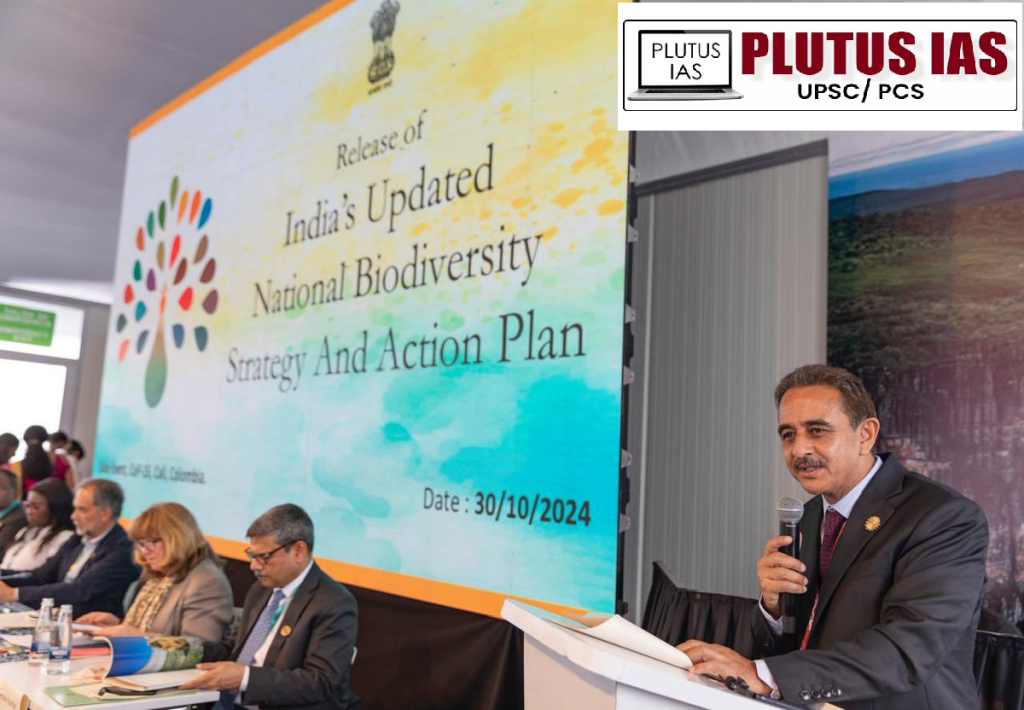07 Nov “Updated NBSAP: India’s Commitment to Protecting Biodiversity and Enhancing Resilience”
SYLLABUS MAPPING:
GS-3-Environment- “Updated NBSAP: India’s Commitment to Protecting Biodiversity and Enhancing Resilience”
FOR PRELIMS:
What is the purpose of India’s National Biodiversity Strategy and Action Plan (NBSAP)?
FOR MAINS:
Discuss the key changes made in India’s updated National Biodiversity Strategy and Action Plan (NBSAP). How do these changes address current environmental challenges?
Why in the news?
Union Minister of State for Environment, Forest and Climate Change, Shri Kirti Vardhan Singh, unveiled India’s updated National Biodiversity Strategy and Action Plan (NBSAP) at the 16th Conference of Parties (COP 16) to the Convention on Biological Diversity (CBD). The release took place during a special event, “Roadmap for achieving the Kunming-Montreal Global Biodiversity Framework targets,” in Cali, Colombia.

What is NBSAP?
The National Biodiversity Strategy and Action Plan (NBSAP) is a comprehensive framework developed by countries to guide their efforts in the conservation and sustainable use of biodiversity.
Article 6 of the Convention on Biological Diversity (CBD) mandates each Contracting Party to develop or adapt national strategies, plans, or programs for the conservation and sustainable use of biodiversity. These strategies must reflect the measures outlined in the Convention, tailored to each country’s specific conditions and capabilities. Furthermore, Article 6(b) emphasizes integrating biodiversity conservation into relevant sectoral and cross-sectoral policies.
Article 26 and Article 10(a) support this by requiring Parties to report on the implementation and effectiveness of these measures, ensuring biodiversity is embedded in national decision-making processes. Together, these articles establish a clear obligation for countries to create national biodiversity strategies and action plans, aligning local efforts with global conservation goals while ensuring accountability and progress.
Key features of NBSAP:
1. Biodiversity Assessment: Identifies and assesses species, ecosystems, and genetic diversity, with a focus on priority areas.
2. Conservation Measures: Establishes protected areas, species conservation plans, and ecosystem restoration efforts.
3. Sustainable Use: Promotes sustainable practices in agriculture, fisheries, and forestry and encourages community participation in conservation.
4. Mainstreaming Biodiversity: Integrates biodiversity into sectoral plans (e.g., agriculture, water, urban planning) and national policies.
5. Monitoring and Reporting: Implements monitoring systems to track biodiversity health and reports progress to international bodies like the CBD.
6. Public Awareness: Raises awareness about biodiversity’s value and builds capacity for local communities and institutions.
7. Research and Knowledge Sharing: Promotes scientific research and integrates traditional knowledge into conservation efforts.
8. Financial Mechanisms: Mobilizes funding for conservation and creates incentives for biodiversity-friendly practices.
Updated target NBSAP:
1 . Ecosystem and Species Conservation: Expand protected areas and implement species-specific recovery plans.
2. Mainstreaming Biodiversity: Integrate biodiversity into sectors like agriculture, forestry, and urban planning.
3. Governance strengthening: focuses on improving legal frameworks, enhancing enforcement, and integrating indigenous knowledge into biodiversity management for more effective and inclusive conservation.
5. Monitoring and Reporting: Strengthen biodiversity monitoring systems and track progress towards global targets.
6. Sustainable Financing: Mobilize funding through innovative mechanisms like PES, biodiversity offsets, and private sector partnerships.
7. Public Awareness: Boost public education on biodiversity and engage communities in conservation efforts.
8. Global Cooperation: Align national efforts with international frameworks and strengthen cross-border collaboration.
Hurdles in achieving target:
2. Policy Fragmentation: Lack of coordination between sectors leads to conflicting policies.
3. Land-Use Change: Urbanization, infrastructure development, and unsustainable agriculture contribute to habitat loss.
4. Climate Change: Ecosystem degradation and species vulnerability are exacerbated by climate impacts.
5. Public Awareness: Low awareness and limited community participation slow conservation efforts.
6. Conflicting Interests: Economic pressures from industries like mining and agriculture conflict with biodiversity goals.
7. Data Gaps: Insufficient biodiversity data and weak monitoring systems hinder progress tracking.
Way forward:
1. Increase Financial Investment: Mobilize diverse funding sources, including public-private partnerships and innovative financing like green bonds.
2. Policy Integration: Mainstream biodiversity into all sectors (agriculture, water, urban planning) and ensure policy coherence.
3. Strengthen Enforcement: Improve legal frameworks and strengthen local governance for better conservation and law enforcement.
4. Community Engagement: Raise public awareness and incentivize community-based conservation and sustainable livelihoods.
5. Enhance Data & Monitoring: Improve biodiversity data collection and implement real-time monitoring systems.
6. Climate Change Adaptation: Promote ecosystem-based adaptation and restore critical ecosystems to build climate resilience.
7. International Cooperation: Align national efforts with global biodiversity frameworks and strengthen regional partnerships.
8. Research & Knowledge Sharing: Invest in scientific research and incorporate traditional knowledge into biodiversity strategies.
Conclusion:
India’s NBSAP adopts a holistic approach to biodiversity conservation by blending traditional practices with modern governance and collaborative methods. Regular updates and active stakeholder involvement highlight the country’s dedication to preserving its biodiversity while tackling current environmental issues. Ongoing efforts in capacity building, resource mobilization, and robust monitoring are essential to meet biodiversity goals and ensure sustainable development for future generations.
Prelims Question:
Q.Consider the following Principles of the NBSAP:
1. It is a strategic policy document that aims at providing direction at a national level on the management and protection of biodiversity.
2. It is the principal instrument for implementing the United Nations Convention on Biological Diversity (CBD) at the national level.
Which of the above-given statements is/are correct?
A. 1 only
B. 2 only
C. Both 1 and 2
D. Neither 1 nor 2
Answer: C
Mains Question:
Q. Analyze the role of the private sector and corporate social responsibility (CSR) in supporting the goals of India’s updated NBSAP. How can businesses contribute to biodiversity conservation in India?
(250 words, 15 marks)



No Comments